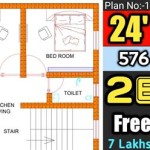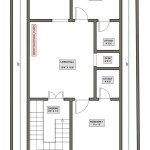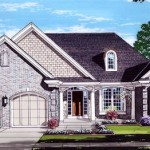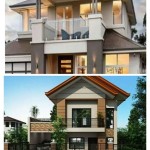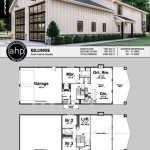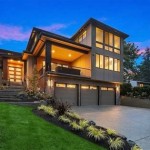Floor Plans for Above Garage Apartments: Maximizing Space and Functionality
Above-garage apartments, also known as garage apartments or accessory dwelling units (ADUs) over garages, are increasingly popular options for homeowners seeking to generate rental income, provide accommodation for family members, or create a private workspace. The success of such a project hinges significantly on a well-designed floor plan. Optimizing the layout maximizes the limited square footage, ensures comfortable living, and complies with local building codes. This article will explore key considerations and common floor plan elements for above-garage apartments.
Understanding the Constraints and Opportunities
Designing a floor plan for an above-garage apartment presents unique challenges and opportunities. The existing structure of the garage dictates the apartment's footprint, often resulting in a rectangular or square shape. Headroom can be a concern, particularly in garages with low rooflines, which can necessitate creative solutions like dormers or vaulted ceilings. However, the separateness from the main house offers privacy and independence for both the homeowner and the tenant. Further, the existing utility connections in the garage can simplify plumbing and electrical installations, reducing construction costs.
Before embarking on the design process, a thorough assessment of the existing garage is crucial. This involves measuring the exact dimensions of the interior space, including height variations due to the roof pitch. Identifying the location of load-bearing walls is also critical as they cannot be easily altered. An engineer or qualified contractor can provide valuable insights into the structural integrity of the garage and its suitability for supporting an apartment. Furthermore, research local zoning regulations and building codes, which often specify requirements for minimum square footage, ceiling height, fire safety, and parking.
Another important consideration is accessibility. Access to the apartment is typically via an exterior staircase. The location and design of this staircase should be carefully planned to comply with code requirements for width, rise, and run. Providing a covered staircase is beneficial, protecting occupants from the elements. For accessibility, if space and budget allow, consider incorporating an elevator or a lift, especially if the apartment is intended for elderly or disabled individuals.
Essential Elements of an Above-Garage Apartment Floor Plan
The floor plan should incorporate all the essential elements of a self-contained living space. These elements include a kitchen, bathroom, living area, and bedroom. Open-concept designs are popular for above-garage apartments because they maximize the sense of space and allow for versatile use of the living area. However, carefully delineating functional zones within the open space through furniture placement or subtle architectural features is important.
The kitchen typically includes a sink, refrigerator, cooktop or range, and storage cabinets. Space-saving appliances, such as a combination microwave-convection oven or a compact refrigerator, are often preferred. The bathroom should have a toilet, sink, and shower. A bathtub is not always necessary, especially in smaller apartments. Utilizing corner showers or wall-mounted sinks can free up valuable floor space.
The bedroom can be a separate room or an alcove within the main living area. If it is a separate room, ensure that it has a window that meets egress requirements for fire safety. A closet is also essential for storage. The living area should be large enough to accommodate seating, a television, and other furniture. Consider the placement of windows to maximize natural light and ventilation.
Storage is a key consideration in any small living space. Incorporate built-in storage solutions, such as shelves, drawers, and cabinets, wherever possible. Utilize vertical space by installing shelves that reach the ceiling. Consider adding storage under the staircase leading to the apartment. Multi-functional furniture, such as a sofa bed or a coffee table with storage, can also help maximize space.
When designing the floor plan, consider the orientation of the apartment relative to the sun. Southern exposure will provide the most natural light throughout the day but can also lead to overheating in the summer. Eastern exposure will provide morning sunlight, while western exposure will bring afternoon sun. Consider using window treatments to control the amount of sunlight entering the apartment. Proper insulation is also essential for energy efficiency and comfort.
Fire safety is paramount. The floor plan must comply with local building codes for fire-resistant construction, smoke detectors, and carbon monoxide detectors. Ensure that the apartment has at least two means of egress, such as a staircase and a fire escape ladder. Consider installing a sprinkler system for added protection.
Common Above-Garage Apartment Floor Plan Configurations
Several common floor plan configurations are popular for above-garage apartments. These configurations can be adapted to suit the specific dimensions of the garage and the needs of the occupants. The "studio" or "efficiency" apartment is the simplest configuration, consisting of a single large room that serves as the living area, bedroom, and kitchen. The bathroom is a separate room. This type of apartment is ideal for single occupants or short-term rentals.
A one-bedroom apartment features a separate bedroom, a living area, a kitchen, and a bathroom. This configuration provides more privacy and separation of spaces than a studio apartment. The bedroom is typically located at the rear of the apartment for added privacy. The living area and kitchen are often combined in an open-concept space.
A two-bedroom apartment is less common but feasible in larger garages. This configuration offers more space for families or roommates. One of the bedrooms is typically smaller than the other. The floor plan must carefully manage the circulation space to fit everything in comfortably.
Another variation is the loft apartment, which features a sleeping loft above the main living area. This configuration is ideal for garages with high ceilings. The loft provides a separate sleeping space while maximizing the open area below. Access to the loft is typically via a ladder or a spiral staircase.
Regardless of the configuration, it's important to maintain a sense of openness and flow within the apartment. Avoid creating long, narrow hallways that can make the space feel cramped. Consider using architectural features like skylights or vaulted ceilings to enhance the feeling of spaciousness. Color schemes and lighting can also impact the perceived size of the space; lighter colors and ample lighting will make the apartment feel larger and more inviting.
The arrangement of appliances and fixtures can significantly affect the functionality of the apartment. Place the refrigerator and stove in close proximity for ease of cooking. Position the sink near a window to provide natural light and ventilation. Install the toilet and shower in separate compartments if space allows.
When designing the bathroom, consider the placement of the door to ensure privacy. Avoid positioning the door directly across from the toilet or shower. Use a pocket door or a sliding door to save space. Install a vent fan to remove moisture and prevent mold growth.
The flooring material can also impact the overall look and feel of the apartment. Hardwood floors are durable and attractive. Tile is ideal for bathrooms and kitchens because it is water-resistant and easy to clean. Carpet provides warmth and comfort in bedrooms and living areas.
Insulation is critical for minimizing noise transfer between the garage and the apartment. Soundproofing measures can include installing resilient channels on the ceiling and walls, using sound-dampening insulation, and sealing any gaps around doors and windows. Solid-core doors can also help reduce noise transmission.
Finally, it is imperative to consult with a qualified architect or designer to develop a floor plan that meets your specific needs and complies with all applicable regulations. A professional can bring valuable expertise and creativity to the project, ensuring that the resulting apartment is both functional and aesthetically pleasing.

Pin On Homes

Garage Living Plan 85372 Farmhouse Style With 1901 Sq Ft 2 Bed

2 Bed 1 Bath 1000 Sqft Above Garage Apartment Plans Floor

Floor Plan For Above Garage Aprtment Apartment Plans

Chic And Versatile Garage Apartment Plans Blog Eplans Com

2 Bed Garage Apartment Above A Car With Traditional Exterior 68964vr Architectural Designs House Plans

Apartment Over Garage Plan

Apartment Garage Plans 1107 1bapt Small House Plan

Pin On Backyard

Plans For A Two Bedroom Apartment Above Car Garage

